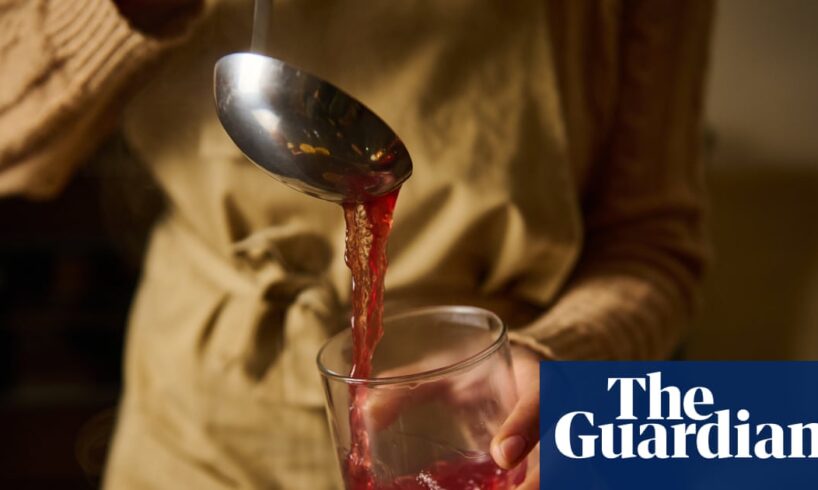
There’s something both medieval and mildly unhinged about heating wine. It feels a little like putting pineapple on pizza or microwaving fish at work, technically permissible but socially questionable.
It’s a tradition that’s believed to date back to the Romans, who simmered red wine long before it was on trend. These days every country has its own version – some better, some bolder and some using white wine.
Revellers drink feuerzangenbowle – fire tongs punch – at a Christmas market. Photograph: Jorge Tutor/Alamy
In the UK, the classic Christmas market Glühwein (which translates to “glow wine”) has become so ubiquitous it’s available bottled in supermarkets, pre-spiced and pre-sugared, ready to be reheated and regretted. Last year white mulled wine also made a push into the mainstream thanks to M&S Food, with mixed feedback. Advocates say it’s lighter and more aromatic, while detractors say it tastes like Savvy B that’s been left in the boot of a car in summer. As with most things, execution is everything.
In Germany and Austria, glühwein is made with hearty reds, vanilla, cloves, citrus and a decent splash of rum or brandy. Sometimes a cone of rum-soaked sugar is placed on top then set alight, to make feuerzangenbowle (fire tongs punch).
In France vin chaud tends to be less sweet and usually includes ginger, black pepper and cognac. In Sweden glögg includes dried fruits, almonds and raisins – sometimes served with a spoon to scoop up the good bits. Vino caliente, spiced with cinnamon and orange peel, is served at winter festivals across Spain and in the Spanish-speaking countries of the Americas. In Spain they typically spike with brandy or rum, while in Colombia and other parts of the Andes it’s often laced with aguardiente, an anise-flavoured spirit. And in Japan you can find both otoso – traditional spiced sake – as well as unusual takes on mulled wine, sometimes adding yuzu peel or plum wine.
In Australia we’re not exactly known for our hot drinks culture – coffee aside – but in cooler climates such as the Adelaide hills, or even Sydney’s unheated sharehouses, mulled wine is an increasingly popular winter treat. It’s warming, social and smells as though you made an effort, even if you didn’t.
What makes a good mulled wine?
First, the wine. While you don’t need to pour anything expensive, don’t go straight for the dregs. Cheap wine is fine so long as it’s not terrible. Twenty bucks is a fair price point, give or take a few dollars. Something medium to full-bodied, fruity and lower in tannins works well, such as merlot, grenache or malbec. Anything too complex is a waste, as the nuances will be lost once you start simmering.
Second, the spices. Whole spices are better than ground. Cinnamon sticks, star anise, cloves and cardamom pods are a great place to start. Citrus is essential and, as for sugar, taste as you go.
Finally, your setting. A pot on the stovetop is a classic but a slow cooker or campfire pot will also step up to the task. Serve in mugs and garnish with a slice of orange to make it feel festive.
skip past newsletter promotion
Sign up to Saved for Later
Catch up on the fun stuff with Guardian Australia’s culture and lifestyle rundown of pop culture, trends and tips
Privacy Notice: Newsletters may contain info about charities, online ads, and content funded by outside parties. For more information see our Privacy Policy. We use Google reCaptcha to protect our website and the Google Privacy Policy and Terms of Service apply.
after newsletter promotion
The South Australian stalwart Taylors Wines serves mulled wine every winter at its cellar door in the Clare Valley. Its chief winemaker, Adam Eggins, kindly shared the recipe with me. “I find mulled wine goes very well with rich cheeses and spicy fruit cake,” he says. “It’s the perfect warming drink, ideal for a Sunday afternoon tipple.”
Taylors Wines mulled wine – recipe
1 bottle (750mL) malbec
1/2 bottle merlot
1 fresh orange, sliced into rounds
6 whole cloves
3 cinnamon sticks
3 star anise pods
1/2 cup brandy
1/4 cup honey
Dried orange slices for garnish
Add all ingredients to a pot and bring to a simmer. Ladle into cups to serve and garnish with a slice of dried orange.





